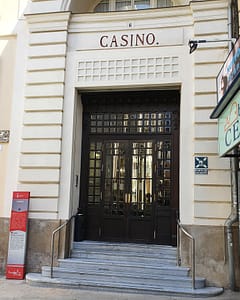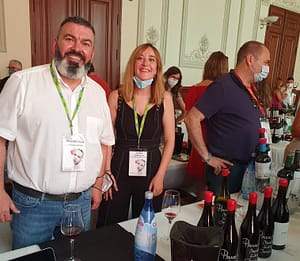I am in Murcia, Spain. And suddenly the opportunity came to visit the third fair held by magazine Verema this summer. The two first ones were held in Palma de Mallorca and Madrid. There will be more tastings later in summer and autumn too. The location in Murcia was the Royal Casino, an emblematic building in the center. It was built from 1847 on, and shows traces of different styles from that period and somewhat later – now declared monument of historic-artistic interest.
I concentrated on the local wineries, that also were best represented here.
I was invited by Parajes del Valle, a winery I hoped to visit, but we didn’t manage to meet at their place this time. They are part of the bigger García Pérez group. In Jumilla they are for me one of the most interesting wineries. The first reason lies in their name, Parajes shows a sense of place. To obtain this I think that their decision to harvest early (first part of September for the monastrell grape, while most pick later that month or even October) and also the light extraction helps.
Director Gregorio Ruiz Abellán and export responsible Gemma Morcillo brought three vintages of their Parajes del Valle, an unoaked wine that is both fresh and cool, and at the same time very Mediterranean with its herbal fruitiness of the local supergrape. It starts in stainless steel, and is transfered to concrete after a while. I have highlighted both the 2018 and 19. Here is the latter, maybe most relevant. For me this has been a house wine through the winter (the article also has a link to the first one). At this moment I would say that the 20 is a bit lighter, maybe more to the fruity side, while the two others are more mineral. But they all are red fruit-driven and stand in the crossroads between the coolness and the rosemary/thyme-herbal Med-landscape.
The terraje system is described in the blogpost about the vintage 2019. In short it consists of renting the vineyard to the farmers, who take care of the quality of the vines, and then some wine is given back to the farmer. Terraje is also the name of their most “ambitious” wine (I feel the scraping of the sword when writing this, because the Parajes is in its way also a very ambitious one). Organic and dry-farmed, just like the other, this one is from older, ungrafted (“pie franco”) monastrell from defined places (parajes) called La Fuente de las Perdices and La Cañada de Albatana to the north of Jumilla town. This wine is made in a similar way, but aged in wooden “foudres”. Even this wine has low extraction with a cherry red colour. It’s fuller and more complex, but follows the same line in acidity and minerality.
Viña Elena I have known for a long time, and also visited Elena Pacheco once. This time it was her sister María together with José Marín who presented the wines.
Located in Estrecho de Marín, a valley surrounded by low mountains south of Jumilla, they offer a varied range, from a light salmon-coloured rosé through monastrell-variations with cabernet and syrah, even the dark, spicy paprika-flavoured cabernet sauvignon varietal Cuco. Very interesting is their Bruma del Estrecho de Marín, a series of single vineyard wines, almost all from monastrell, some from the vineyards owned by two brothers over in the Albacete province of Castilla-La Mancha. The Parcela Particiones 2020 is a clarete from sandy soils. In Spain clarete means a blend of red and white grapes (whereas in Portugal this is called palhete, and clarete is a light wine from red grapes). It’s an elegant monastrell and airén blend without malolactic fermentation; smells of cherry and other stone-fruits and has quite a bit of tannins. Paraje Marín 2019 from stony soils was fabulous and fresh, with typical Mediterranean herbs and somewhat warm fruit. Paraje Las Chozas 2018 was a bit darker and with young tannins, but still fresh and cool, iodine and salty. Parcela Navajuelos 2018 from sandy soils was light in colour, fresh, fruity and cool with some spice. While Parcela Vereda 2018 was darker, with forest fruits (like blackberry) and some warmth from the clay soils, while the chalky part gives also this wine some saltiness. These fabulous wines and the parcel/paraje concept contribute to make Jumilla a wine region to watch in the years to come.
Bodegas Carchelo I knew well in the times of founder Agapito Rico, one of the great personalities in Jumilla from the early 1980’s. At that time he was quite a revolutionary with his fresh, concentrated, yet good value wines. It was nice to be able to catch up and meet David Ferraje from the team of new owners that took over a little more than ten years ago.
They are located to the east of Jumilla, at the foot of the mountains Sierra del Carche, hence the name. And most of the vineyards are quite near, north-northeast of the town. Today they are 100% organic. I have enjoyed several of their wines, from the young and fresh rosé via the simple and fun Eya Tinto 2020 and the dark fruit-driven Carchelo Roble 2019 (monastrell with cabernet and tempranillo) – to the more ambitious part of their range. Here you find f.ex Canalizo 2014, a monastrell-syrah-tempranillo aged 20 months in barrel. This one had aged beautifully; mature morellos, tea, dried fruits and a nice bitter tone. Muri Veteres 2016, a pie franco monastrell with dark fruits and balsamic notes, was elegant and attractive.
It’s maybe a bit strange to say that one of the surprises was Juan Gil. But the Gil Family Estates has turned into a conglomerate of bodegas across the country. I don’t know the quality of all of them, but the original (bodega founded by Juan Gil Giménez in 1916) was quite good. They are in transition to organic cultivation, with the majority of vineyards northeast towards Yecla.
In short, the young white and rosé were good, but not with much personality. The new project over in Almansa, named Bodegas Atalaya, has potential, but at this point too much oak for me. Here I chose as a representative Juan Gil‘s own Honoro Vera 2020, a varietal monastrell, organically farmed, unoaked and vegan certified. This was a quite fresh dry-farmed wine from calcareous and rocky soils, with the usual red and dark berries and balsamic notes.
From neighbouring Yecla, a one-municipality-denomination, I tasted the wines of its leading winery. Bodegas Castaño had good offerings from the unoaked white and rosé to the dense and rich Casa Cisca, and neither have I forgotten that they have one of the best sweet monastrell wines (not brought to this tasting). Among the most interesting wines is an old favourite, now called Hécula Organic in the 2019 vintage. It shows ripe red berries (morello), aromatic herbs and a hint of coffee. Full and quite fresh in the mouth with mature tannins. I will come back to this one in a while.








